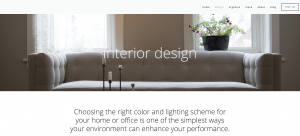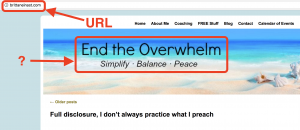 Take a look at the title of this post again. It is 3 Essential Elements Every Web Page Must Have, not 3 Essential Elements Every Web Site Must Have. There’s a big difference. I’m talking about every single page on your website. Let’s get to it.
Take a look at the title of this post again. It is 3 Essential Elements Every Web Page Must Have, not 3 Essential Elements Every Web Site Must Have. There’s a big difference. I’m talking about every single page on your website. Let’s get to it.
Every page on your website, no matter what it is – whether it’s a landing page, sales page, membership page, shopping cart page, etc. must have…
Confidence-Building Brand Identity
It happens more than you might think – a web page with no logo, site title or brand identity. For example, here is a screenshot from a great website. There’s just one small problem…

There’s no brand representation. No logo. No site title. There’s a title on the homepage, but that’s it.
The other thing I’ve seen happen quite frequently is a web page that has confusing or conflicting branding. For example, the domain name says one thing, but the logo or site title says something completely different. Here’s an example…

Which is it? People will find it hard to trust you or like you if your brand is unclear or invisible.
You’ve heard that phrase that people do business with people they know, like and trust, right?
I’ve discovered that it has to happen in that order as well. Rarely can anyone trust you if they don’t like you, and certainly no one can like or trust you if they don’t know you.
Who are you? It must be clear on every single page of your site. If you also have a brief tagline that describes who you are, so much the better.
And the look and feel…?
Having a clear and consistent business name across your web pages is just the beginning of building your brand identity, though.
There are several aspects to building brand confidence, such as your story, your products and services, and more, that are outside the scope of this discussion. One other factor that I do want you to consider, though, is the look of your page. What does your web page look like? Does it give the impression that you are…well…pretty amazing? Or, are folks a bit underwhelmed by the look and feel of it? Is it consistent with all the other pages, or do you bounce to different websites for particular links? For example, if someone clicks on “Blog” does it take them to a different website?
Having a clear, consistent site title on every page, with a matching URL and eye-catching design that is consistent with the rest of the site is the first step in building brand identity and confidence and the first thing every web page must have.
Relevant Value
Does each page of your website either educate, inspire or entertain your visitor? Do they leave your web page a smarter, confident, happier, less frustrated or more well-informed citizen? Was their time on your web page well-spent? Would they tell others about their experience? Do they know what to do next?
Don’t confuse content with value. Just because you have a lot of content doesn’t mean people will find it valuable. The home page is often the biggest culprit. People will put a message like, “Welcome to my website!” That’s not valuable content. That’s fluff. That’s like a marshmallow. It may seem sweet and take up space, but it ain’t good for ya.
There are also a lot of what I call vanity pages. That’s a page where – usually an artist or musician (and I can pick on them because I am one) – will just talk about themselves… “Hey, look at me here! Hey, now look at me doing this neat thing over here.” Those are fun, but seriously, who cares? Do you check the analytics of those pages to see what kind of engagement they are getting and what kinds of actions people are taking as a result?
You may want to go through your website page by page and do a reality check. Look at your pages through a visitor’s perspective. Is it relevant and valuable or is it just fluff?
Not only is it necessary to provide relevant value, but that valuable content must be easy to find. Your content must be well organized, labeled and searchable. For example, I visited the home page of a musician, and all he had on his page were videos. They were categorized, but there were no titles. I guess we’re just supposed to watch everything to know what it’s about? That’s asking a lot of your visitor. Chances are they will just turn away without looking at anything…unless, of course, you’re one of the most well-known artists or brands around today.
A next-level step for this would be asking yourself if your content is optimized for search engine results. It would be a shame to have some great, relevant, valuable content…and no one could find it.
Invitation to Riot
Kidding…sort of.
It’s just that “Call to Action” is such a boring expression.
In 1913 the debut performance of Igor Stravinsky’s The Rite of Spring came as such a culture shock that it caused a riot. In other words…it forced people to take action.
What action do you want a visitor to take after consuming the amazing content on your page? Maybe not cause a riot, unless that riot is people beating down your doors in droves to get their hands on your products and/or services. This should be a clear and deliberate step that is in line with your business objectives.
Most businesses have a main objective, or at least a very high priority, of generating new leads. Does every page on your site invite the visitor to take the next step in the relationship with you?
You’ll often see links at the bottom of the page that invite you to check out related content. While clicking a link for related content may get visitors to engage with your site and stay on it a bit longer, it’s not necessarily going to generate any new leads. Clicking on a link for related content is technically a call to action, but it’s not a very strong one.
One of the best calls to action you can have on every page of your site is an offer for people to join your mailing list. That way, you can continue to follow up with them once they leave your site. The best way to get them to join your mailing list is to offer them more free valuable content. In other words, the call to action must cause them to riot, so to speak. For example, the invitation to “join my newsletter to stay on top of what I’m up to” or “be the first to know what I’m up to” is not compelling. “Download my entire album for free” – now THAT’s a CTA that will cause a riot.
“Whatever your CTA is, it must be compelling, or people will not riot.”
If you want them to watch a video, give them a good reason to. Tell them how this video is going to solve their problems.
One time I had a musician tell me that they were not focusing on building a mailing list on their website because their main intended audience were record labels. Well, record label execs are not idiots. If they see you are not doing anything to build a raving fan database, they’re going to wonder if you have any fans at all!
Lastly, I’d like you to notice that the element here is a call to action, not calls to action.
I’ve seen many web pages with so many different calls to action that I had no idea what to do, and clearly the web designer had no idea what they really wanted me to do either. This mistake could have been avoided if they had simply sat down and come up with clear objectives for each page of their site. So, really, the pre-cursor to having a clear CTA on your page is having a clear objective in your mind on how you want to lead your web page visitor deeper into the web or your business relationship.
Need More?
Grab your FREE Cheat Sheet: 7 Secrets to a Website That Rocks!
I wanted to start the discussion by saying that I think this post is very helpful. Thanks!